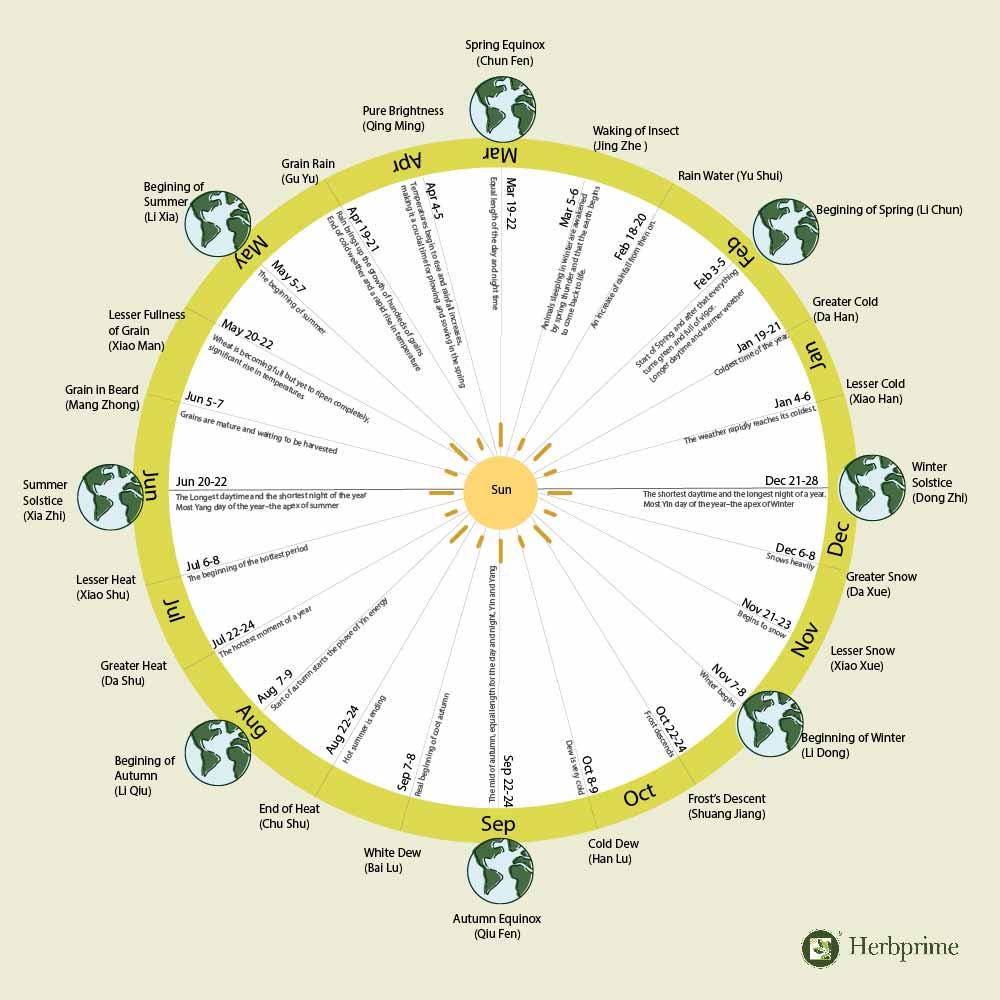Navigating Nature's Calendar: A Comprehensive Guide to China's 24 Solar Terms

In the rich tapestry of Chinese culture and agricultural practices, the 24 Solar Terms stand as a fascinating and intricate calendar system. Rooted in ancient wisdom, these terms encapsulate the subtle changes in climate, guiding farmers and communities through the nuances of each season. Join us as we embark on a journey to explore the significance of the 24 Solar Terms and how they continue to shape the rhythm of life.
Understanding the 24 Solar Terms: The 24 Solar Terms, or Jieqi, represent key points in the solar year, dividing it into 24 segments. Each term corresponds to specific celestial events, marking transitions in weather patterns, agriculture, and traditional Chinese medicine practices. From the frosty "Beginning of Winter" to the blossoming "Awakening of Insects," these terms offer a nuanced perspective on the cyclical nature of life.
Agricultural Significance: For farmers, the 24 Solar Terms serve as a vital guide for planting and harvesting. Understanding these terms allows for precise timing in agricultural activities, ensuring optimal growth conditions for crops. From sowing seeds during the "Grain Rain" to harvesting during the "End of Heat," aligning with these terms maximizes agricultural productivity.
Cultural Celebrations: The Solar Terms are not merely markers of agricultural cycles but are woven into the fabric of cultural celebrations. Festivals like Dongzhi (Winter Solstice) and Qingming (Pure Brightness) are intricately linked to specific Solar Terms, reflecting a harmonious blend of nature and tradition.
Traditional Chinese Medicine Insights: In the realm of Traditional Chinese Medicine (TCM), the 24 Solar Terms guide health practices. The ebb and flow of Yin and Yang energies during these terms influence recommendations for diet, exercise, and overall wellness. By aligning with nature's rhythm, individuals can enhance their vitality and well-being.
Date |
Solar Term |
Description |
Jan 4-6 |
Lesser Cold (Xiao Han) |
The weather rapidly reaches its coldest. |
Jan 19-21 |
Greater Cold (Da Han) |
Coldest time of the year. |
Feb 3-5 |
Beginning of Spring (Li Chun) |
Start of Spring and after that everything turns green and full of vigor. Longer daytime and warmer weather |
Feb 18-20 |
Rain Water (Yu Shui) |
An increase of rainfall from then on. |
Mar 5-6 |
Waking of Insect (Jing Zhe ) |
Animals sleeping in winter are awakened by spring thunder and that the earth begins to come back to life. |
Mar 19-22 |
Spring Equinox(Chun Fen) |
Equal length of the day and night time |
Apr 4-5 |
Pure Brightness(Qing Ming) |
Temperatures begin to rise and rainfall increases, making it a crucial time for ploughing and sowing in the spring |
Apr 19-21 |
Grain Rain(Gu Yu) |
Rain brings up the growth of hundreds of grains。 End of cold weather and a rapid rise in temperature |
May 5-7 |
Beginning of Summer(Li Xia) |
The beginning of summer |
May 20-22 |
Lesser Fullness of Grain (Xiao Man) |
Wheat is becoming full but yet to ripen completely,significant rise in temperatures |
Jun 5-7 |
Grain in Beard(Mang Zhong) |
Grains are mature and waiting to be harvested |
Jun 20-22 |
Summer Solstice (Xia Zhi) |
The Longest daytime and the shortest night of the yearMost Yang day of the year–the apex of summer |
Jul 6-8 |
Lesser Heat(Xiao Shu) |
The beginning of the hottest period |
Jul 22-24 |
Greater Heat (Da Shu) |
The hottest moment of a year |
Aug 7-9 |
Beginning of Autumn (Li Qiu) |
Start of autumn starts the phase of Yin energy |
Aug 22-24 |
End of Heat (Chu Shu) |
Hot summer is ending |
Sep 7-8 |
White Dew(Bai Lu) |
Real beginning of cool autumn |
Sep 22-24 |
Autumn Equinox(Qiu Fen) |
The mid of autumn, equal length for the day and night, Yin and Yang |
Oct 8-9 |
Cold Dew (Han Lu) |
Dew is very cold |
Oct 22-24 |
Frost’s Descent (Shuang Jiang) |
Frost descends |
Frost’s Descent(Shuang Jiang) |
Beginning of Winter (Li Dong) |
Winter begins |
Nov 21-23 |
Lesser Snow (Xiao Xue) |
Begins to snow |
Dec 6-8 |
Greater Snow (Da Xue) |
Snows heavily |
Dec 21-28 |
Winter Solstice (Dong Zhi) |
The shortest daytime and the longest night of a year.Most Yin day of the year–the apex of Winter |


